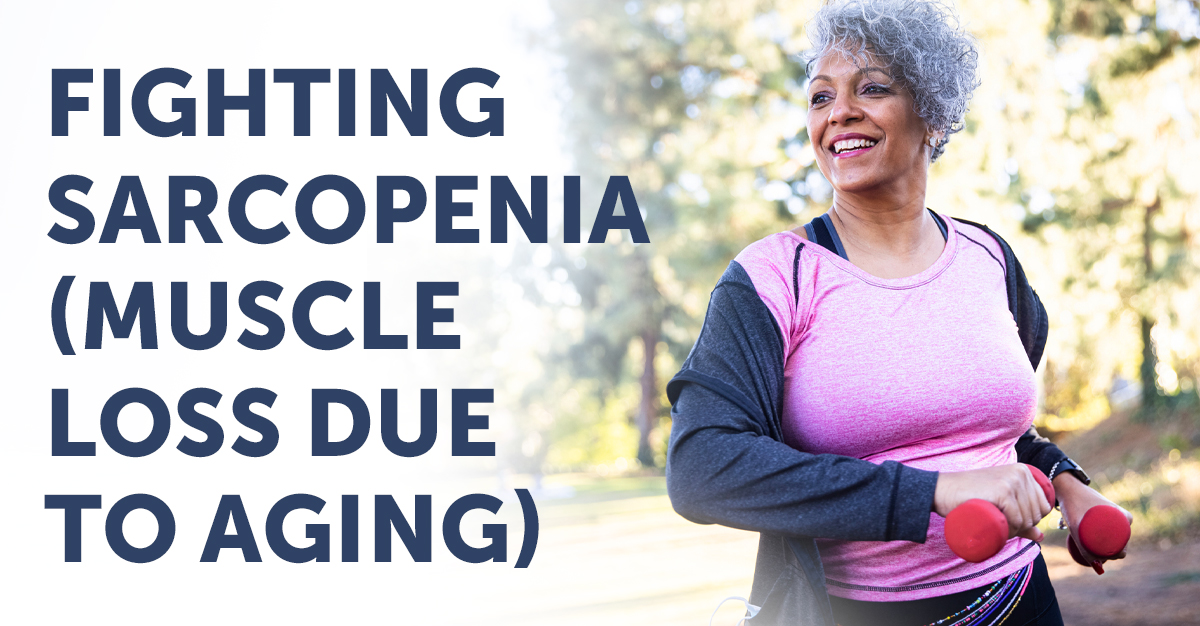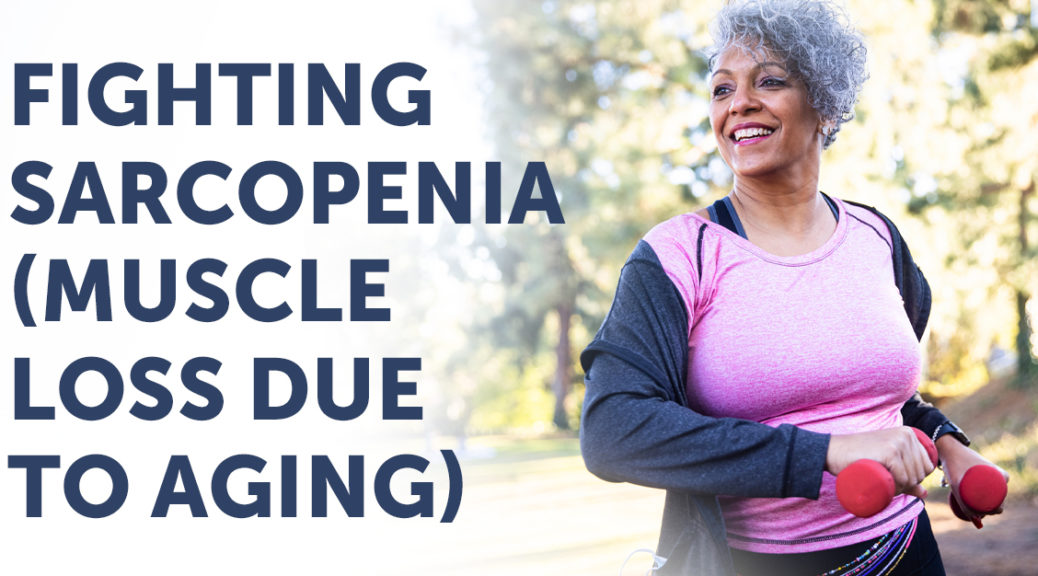
Sarcopenia, or muscle loss due to the normal aging process, is common as the body becomes resistant to regular growth signals. After a person turns 30 years old, the average rate of muscle mass decrease per decade can be as high as 8%(1). Sarcopenia causes a person’s body to become functionally impaired and frail in old age. It is estimated that the range of clinical sarcopenia exists as low as 8.8% in older women and up to 17.5% in older men(2). Older people who experience this muscle-wasting condition have various treatment options, including physical therapy and body contouring for muscle loss. These non-surgical cosmetic treatments can help to firm and tone muscles.
How Does Aging Cause Muscle Loss?
Adults usually achieve peak muscle mass at some point during their early 40s(3). Gradual muscle loss happens afterward. Age-related decrease of skeletal muscle mass and disease can affect muscle performance and physical function. Meanwhile, the decrease in physical function and mobility connected to sarcopenia can lead to falls(4).
Researchers are studying ways to slow, reverse, or prevent such conditions. Medical professionals diagnose sarcopenia by examining flexors and extensors for signs of muscle loss. People can also take steps to slow or reverse muscle loss due to aging.
Overcome the Main Factors that Accelerate Muscle Loss
Besides the normal aging process, other factors can cause a muscle imbalance, including:
- Not Moving Enough: Inactivity includes a sedentary lifestyle, like sitting at a desk all day or lying in bed after an illness or injury.
Not using muscles is a common trigger of sarcopenia(5), resulting in faster muscle loss and increased weakness. - Inflammation: Inflammation helps the body rebuild damaged cells after injury or illness. Long-term diseases like rheumatoid arthritis (RA), however, can cause inflammation that leads to muscle loss. A person’s body may experience decreased muscle mass due to a low-protein or low-calorie diet. Other factors include age-related lifestyle changes, such as problems cooking or altered sense of taste.
- Chronic Physical Stress: Sarcopenia becomes more common in several health conditions that increase stress on the body, such as chronic kidney disease(6).
Exercise Regularly
Keeping muscles active is one of the most effective methods to fight sarcopenia. As the timeless adage goes, “If you don’t use it, you lose it.” A good workout program combines weight-resistance exercises, aerobic exercises, and balance training. An older adult should consider doing two to four exercise sessions every week to get the optimum results(7).
Here are some of the best types of exercises to consider:
- Fitness Training: Physical activity like endurance training and aerobic exercise can help control sarcopenia. Older adults could combine aerobic and resistance exercises for workout programs(8).
More research is needed to determine whether aerobic exercises without weight resistance exercises would produce the same results. - Resistance Training: Some examples include weightlifting and resistance bands. These exercises create tiny tears in muscle fibers, boosting muscle strength and muscle mass(9).
- Walking: Significantly reducing walking for two or three weeks can drastically reduce muscle mass and strength(10). Another benefit of this exercise is that it is usually free unless people walk on a treadmill in a commercial gym. Senior citizens can take different approaches to add more steps to their daily lives. For example, they can try to increase their daily walking distance by 10% every month.
Boost Intake of Muscle-Friendly Substances
A diet deficient in protein, particular vitamins, and minerals, or calories can cause a higher risk of muscle wasting. Here are some nutrients people can add to their diets:
- Protein; Nutritional issues like protein deficiency become more common among adults over 60 years old(11).
Some good sources include:
● Meat
● Fish
● Eggs
● Soy
● Whey
Leucine is among the nine essential amino acids (EAA) people must get from food and supplements. Its functions include increasing muscle mass(12).
- Amino Acid (Creatine): The liver, kidneys, and pancreas make this byproduct amino acid. Sources like meat or Creatine supplements might trigger muscle growth.
- Vitamin D: Studies show Vitamin D deficiency is linked to sarcopenia. However, more research is needed about the reasons for this relationship(13).
Minimally processed food is always the best source of nutrients. Nevertheless, some studies show that Vitamin D supplements may boost muscle strength(14). - Omega-3 Fatty Acids: Fatty fish like tuna, salmon, and mackerel, and shellfish are some foods high in omega-3. They could also boost muscle growth, although more research is needed about whether this is due to omega 3’s anti-inflammatory properties(15).
Get a Good Night’s Sleep
Research on the possible relationship between sleep disorders and sarcopenia is limited(16). However, a recent study showed a possible link between these two health conditions among seniors.
Sleep experts have learned that getting enough sleep is beneficial for muscles through tissue repair and growth(17). More research is needed to determine whether sleep and age-related sarcopenia are connected(18).
If you suffer from muscle loss or are in need of a strengthening program please reach out to one of our physical therapy teams near you.
References
- Muscle tissue changes with aging: https://www.ncbi.nlm.nih.gov/pmc/articles/PMC2804956/
- Sarcopenia: https://mayoclinic.pure.elsevier.com/en/publications/sarcopenia
- Slowing or reverse muscle loss https://www.mayoclinic.org/medical-professionals/physical-medicine-rehabilitation/news/slowing-or-reversing-muscle-loss/mac-20431104
- Ibid
- Sarcopenia: https://mayoclinic.pure.elsevier.com/en/publications/sarcopenia
- Sarcopenia in patients with chronic liver disease: https://pubmed.ncbi.nlm.nih.gov/27372291/
- Exercise frequency, health risk factors, and diseases of the elderly: https://pubmed.ncbi.nlm.nih.gov/23748185/
- How can you avoid muscle loss as you age?: https://health.clevelandclinic.org/how-can-you-avoid-muscle-loss-as-you-age/
- Want to lose weight? Build muscle: https://health.clevelandclinic.org/build-muscles-lose-weight-by-adding-strength-training-to-your-workout/
- Role of exercise in age-related sarcopenia: https://www.ncbi.nlm.nih.gov/pmc/articles/PMC6165967/
- How older adults can stay on track to eat healthfully: https://health.clevelandclinic.org/how-to-age-better-by-eating-more-healthfully/
- Leucine: https://www.urmc.rochester.edu/encyclopedia/content.aspx?contenttypeid=19&contentid=Leucine
- Sarcopenia in post-menopausal women: https://pubmed.ncbi.nlm.nih.gov/25882761/
- Effects of vitamin D on muscle function and performance: https://www.ncbi.nlm.nih.gov/pmc/articles/PMC3513873/
- The influence of omega-3 fatty acids on skeletal muscle protein turnover in health, disuse, and disease: https://www.ncbi.nlm.nih.gov/pmc/articles/PMC6742725/
- Association between sleep duration and sarcopenia among community-dwelling older adults: https://www.ncbi.nlm.nih.gov/pmc/articles/PMC5348186/
- Sleep and muscle recovery: https://pubmed.ncbi.nlm.nih.gov/21550729/
- The impact of sleep on age-related sarcopenia: https://pubmed.ncbi.nlm.nih.gov/26216211/

